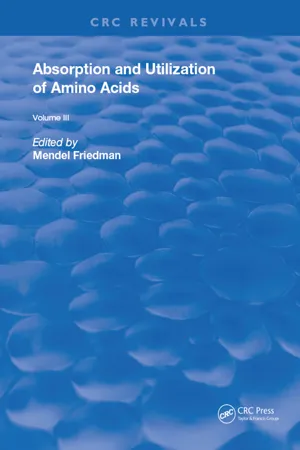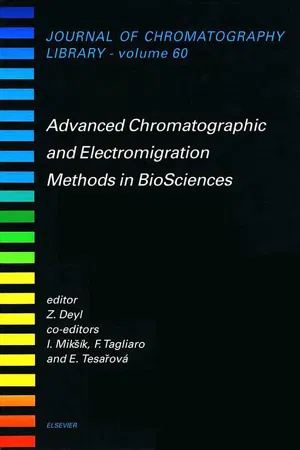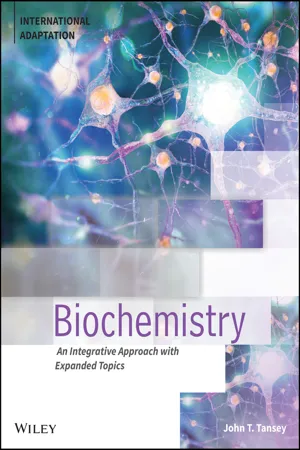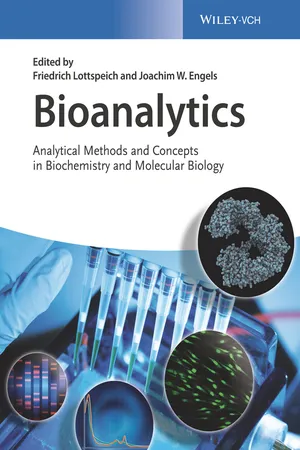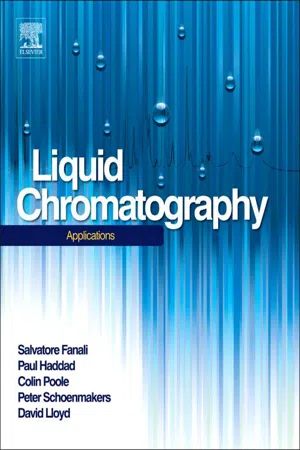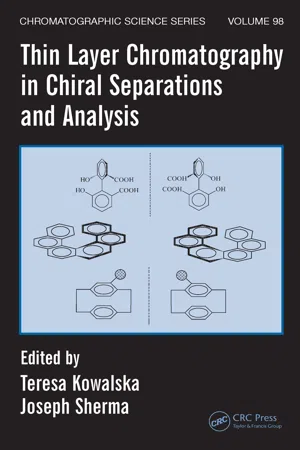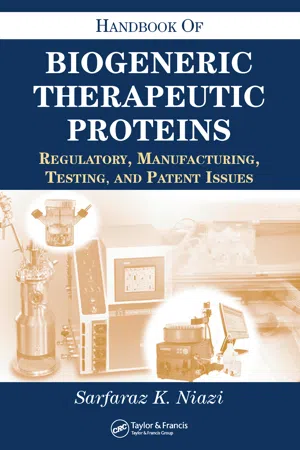Chemistry
Separation of Amino Acids
The separation of amino acids involves the process of isolating individual amino acids from a mixture. This can be achieved through techniques such as chromatography, which exploits differences in the chemical properties of the amino acids to separate them. The resulting isolated amino acids can then be further analyzed or utilized for various applications.
Written by Perlego with AI-assistance
Related key terms
Related key terms
1 of 4
Related key terms
1 of 3
8 Key excerpts on "Separation of Amino Acids"
- eBook - ePub
- Mendel Friedman(Author)
- 2018(Publication Date)
- CRC Press(Publisher)
vide supra) and with the increasing interest in use of highly sensitive HPLC methods, the contamination can cause problems. Central and important steps, both in traditional and new efficient and simple methods of amino acid analysis, are the extraction, isolation, concentration, and group separation prior to liquid chromatography. The methods are adapted to and comprised amino acids present in foods, body fluids, microorganisms, and animal and plant tissues.A. Relatively Large Scale ProceduresIsolation of pure amino acids and separation of structurally related amino acids require homogenization and solvent extractions using large quantities of solvents, reduction of sample volumes, and use of relatively large columns. These techniques based on different types of ion-exchange columns are described in detail elsewhere.10 , 32 , 33 The separations on strongly acidic cation-exchange resins, including the amino acid analyzers, are mainly determined by pKa1 -values (see Tables 1 and 2 ) and adsorption properties of the amino acids.10 , 32 The separations on strongly basic anion-exchange resins are obtained essentially according to pKa2 -values (Tables 1 and 2 ) and adsorption properties of the amino acid.10 , 15 , 33 , 34 Special and gentle methods are used to avoid artifact problems10 , 19 , 34 during extraction and isolation procedures.B. Semimicro Isolation, Purification and Group SeparationThe technique developed for sample preparation and group separation of natural products6 separates amino acids into basic, neutral, and acidic groups.Following extraction, the amino acids are isolated (Figure 6 ) with the basic amino acids in the eluate from column (A). The neutral and acidic amino acids from column (B) are separated by re-chromatography on column (C) leaving the neutral amino acids in the water effluent and the acidic amino acids in the pyridine eluate.This group separation technique is based on ion-exchange columns. The methods are, however, not traditional ion-exchange techniques. For the columns (A) and (C), the retained ions are released and eluted by use of an eluent (volatile) which removes the charge on the column materials. For the (B) column, it is the positive net charge on the retained compounds which are removed by the elulent (volatile), and by use of the (A) before the (B) column the ions on the (B) column can be eluted by gentle conditions. - I. Mikšík, F. Tagliaro, E. Tesarová, Z. Deyl(Authors)
- 1998(Publication Date)
- Elsevier Science(Publisher)
Chapter 11Amino Acids
Ibolya Molnár-Perl Institute of Inorganic and Analytical Chemistry, L. Eötvös University, H-1518,Budapest 112, P.O. Box 32, Hungary11.1 INTRODUCTION
This review was initiated to present the state of the art in the development of chromatographic methodologies. Considerable advances have been made in theoretical approaches, instrumentation, and applications of chromatographic techniques in the past decade. In order to conform with space constraints and to provide a simple overview, the different methods in Tables are presented in a unified format.This selective review is based on the literature of chromatographic methods published from 1992 in the Journal of Chromatography (A and B), Chromatographia, Journal of Chromatographic Science, Journal of Liquid Chromatography, Journal of Planar Chromatography, Analytical Chemistry, Analytical Biochemistry, Analytica Chimica Acta, Analyst, and in Chemical Abstract (for journals not available to the author).The separation of racemates and enantiomers will be discussed. The leading principle of the grouping is to give separate discussion of methods dealing with the free- and with the derivatized amino acids (AAs).The separation of the most important protein amino acids (classically, twenty) is made today by a number of routine procedures (IEC, GC, HPLC), and a current trend in amino acid analysis is attacking the problem of enantiomer separations.11.2 HIGH-PERFORMANCE LIQUID CHROMATOGRAPHY (HPLC)
11.2.1 Separation of underivatized amino acids (Table 11.1 )
Publications dealing with the separation of underivatized AAs are based mainly on ligand-exchange mechanisms [1 ,2 ,8 ] and ion-pair formation [3 -5 ], including the method which is also used in practice [5 ]. A simple, fast and highly reproducible procedure has been proposed for the quantitation of mucolyticums in granule (for N-acetyl-l -cysteine), in capsules (for methylcysteine) and in tablets (S-carboxy-methylcysteine) [5- eBook - ePub
Biochemistry
An Integrative Approach with Expanded Topics
- John T. Tansey(Author)
- 2022(Publication Date)
- Wiley(Publisher)
Chapter OutlineThis chapter begins by discussing amino acids, the building blocks of proteins, then moves on to the basics of protein structure and a brief description of how these macromolecules fold into their specific conformations. Several different examples of different proteins are examined next. The chapter then discusses the basic scheme for conducting a purification, isolating a single protein of interest from a crude mixture. The next section discusses size-exclusion chromatography, a common means of achieving that separation, followed by discussion on use of affinity and ion exchange chromatography techniques to achieve separation. These same techniques can also be used to determine many of the properties of proteins and sometimes their functions.3.1 Amino Acid Chemistry3.2 Proteins Are Polymers of Amino Acids3.3 Proteins Are Molecules of Defined Shape and Structure3.4 Examples of Protein Structures and Functions3.5 Protein Purification Basics3.6 Size-Exclusion Chromatography3.7 Affinity ChromatographyCommon ThemesEvolution’s outcomes are conserved.• Mutations to DNA sequences may result in alterations to a protein’s amino acid sequence. The new protein may function normally, have a new and slightly altered function, or be completely nonfunctional.• The amino acid sequence of proteins can help establish the evolutionary relationship between organisms.• Protein structures and the amino acids they are made from have undergone billions of years of natural selection and random change (genetic drift).• Proteins with conserved amino acid sequences or folds may have similar topology or ligand binding; these attributes can guide the development of purification schemes.Structure determines function.• - eBook - ePub
Bioanalytics
Analytical Methods and Concepts in Biochemistry and Molecular Biology
- Friedrich Lottspeich, Joachim W. Engels(Authors)
- 2018(Publication Date)
- Wiley(Publisher)
Besides its role in protein analytics, amino acid analysis increasingly plays a considerable role in other domains like clinical diagnostic, biomedical research, bioengineering, and foodstuffs industry. For this purpose different technologies have been developed and commercialized. There is still tremendous need to improve these technologies in respect of speed, robustness, reproducibility, and sensitivity. The focus is thereby shifting from the analysis of protein hydrolysates towards the analysis of free amino acids in different biological matrices.Amino acid analysis was first developed by Stein and Moore in 1948. Their method used 6 M HCl for acid hydrolysis in an oxygen-free sphere at 110 °C for 22 h to release amino acids from proteins. They started to separate the free amino acids using starch columns and detected and quantified the eluted amino acids using a post-column ninhydrin reaction. They soon switched to sulfonated polystyrene beads (Dowex 50). The separation of protein hydrolysates still needed five days, which was half the time necessary when using starch columns as stationary phase. As solvent systems lithium or sodium citrate buffers were used. In principle, this method only differed from the method used today in the amount of analyzed material. In 1958 the separation of an amino acid hydrolysate could already be completed within 24 h. Spackman in the same year published an “instrument to automatically record the color yield of ninhydrin,” achieving the quantitative determination of 100 nmol amino acids with an accuracy of 3%. This system turned out to be the classical method for amino acid analysis. For this work Stein and Moore were awarded the Nobel Prize in Chemistry 1972.Chromatographic Separation Techniques, Chapter 10Amino acids are small polar molecules that are difficult to separate from each other except by ion exchange chromatography. The separation is carried out with cation-exchange columns that utilize the zwitterionic nature of amino acids properties, whereby, depending on the presence of amino or carboxyl groups, the amino acids can be either negatively or positively charged, depending on the pH of the buffer. Usually amino acids are loaded onto the column in low pH-buffer, which binds the positively charged amino acids to the column resin. Amino acids are then released using increasing ionic strength and pH. Amino acids cannot be easily detected by UV-absorbance or fluorescent and have to be derivatized after elution from the column. During the late-1970s new derivatization techniques allowed for an improvement of the chromatographic as well as detection properties, leading to new systems for amino acid analysis. The introduction of reversed phase HPLC had a crucial impact, decreasing run times to 30 min. Recently, with the development of ultrahigh pressure liquid chromatography (UHPLC) systems, the resolution of the columns has been be increased, resulting in run times for hydrolysates of below 10 min. - eBook - ePub
Liquid Chromatography
Applications
- Salvatore Fanali, Paul R. Haddad, Colin Poole, David K. Lloyd(Authors)
- 2013(Publication Date)
- Elsevier(Publisher)
Chapter 6 Amino Acid and Bioamine SeparationsY. Miyoshi, T. Oyama, R. Koga and K. Hamase, Graduate School of Pharmaceutical Sciences, Kyushu University, Fukuoka, JapanOutline6.1. Introduction6.2. Direct Separation of Amino Acids and Amines6.2.1. Postcolumn Colorimetric Derivatization with Ninhydrin6.2.2. Postcolumn Fluorescence Derivatization with o -Phthalaldehyde6.2.3. Postcolumn Fluorescence Derivatization with Fluorescamine6.2.4. ESI–MS/MS Determination of Underivatized Amino Acids6.3. Indirect Separation of Amino Acids and Amines6.3.1. Derivatization with UV–Vis Reagents6.3.2. Derivatization with Fluorescent Reagents6.3.3. Derivatization for Mass Spectrometric Detection6.4. Enantioselective Liquid Chromatographic Analysis of Amino Acids6.4.1. 1-Fluoro-2,4-Dinitrophenyl-5-L -Alanine Amide _(Marfey’s Reagent)6.4.2. o -Phthalaldehyde plus Chiral Thiols6.4.3. (+)-1-(9-Fluorenyl)Ethyl Chloroformate6.4.4. Cyclodextrin-Bonded Chiral Stationary Phase6.4.5. Cinchona-Alkaloid-Bonded Chiral Stationary Phase6.4.6. Two-Dimensional Liquid Chromatographic _Analysis of Amino Acid Enantiomers6.5. ConclusionsReferences6.1 Introduction
Amino acids and bioamines play crucial roles in living systems, and liquid chromatographic separation–determination techniques for amino acids and bioamines are essential tools for a wide range of research areas, including life science, food chemistry, environmental analysis, and pharmaceutical science. Liquid chromatographic methods for the determination of amino acids and amino compounds are mainly classified into two approaches. The direct Separation of Amino Acids and amines followed by postcolumn derivatization with colorogenic or fluorogenic reagents or direct separation followed by mass spectrometric detection. The second approach is the indirect Separation of Amino Acids and amines following precolumn derivatization with reagents suitable for the detection of these compounds with various detectors. In this chapter, we provide an overview of the liquid chromatographic analysis of amino acids and biological amines, including enantioselective analysis of amino acids. - Teresa Kowalska, Joseph Sherma(Authors)
- 2007(Publication Date)
- CRC Press(Publisher)
12 Chiral Separation of Amino Acid Enantiomers Władysław Gołkiewicz and Beata Polak CONTENTS- 12.1 Introduction
- 12.2 Separation of Amino Acid Enantiomers on the Commercial Chiral Plates
- 12.3 Separation of Amino Acid Enantiomers on the Impregnated Plates with Chiral Reagent
- 12.4 Separation of Amino Acid Enantiomers on the Commercial Plates with Chiral Reagent in Mobile Phase
- 12.5 Most Popular Chiral Reagents Used for Derivatization of Amino Acid Enantiomers
- 12.6 Conclusions
- References
12.1 Introduction
About 20 L -amino acids are the building blocks of proteins, so there is no need to use the chiral chromatographic techniques to resolve such mixtures; there are many different chromatographic techniques that allow to separate mixture of L -amino acids (for a review see [1 ]).On the other hand, the optically active amino acids can be converted into a racemic mixture by racemization reaction [2 ]. In reality, racemization reaction, especially when occurring in fossil or teeth [3 ], takes a lot of time, but it has also become established that racemization takes place with higher reaction rates, at natural pH as well as in dilute acid or base [2 ].Racemization in the metabolically stable proteins has also been detected [2 ,4 –6 ].Supplementation of livestock feeds with certain amino acid enantiomers has generated interest in analyses of D - and L -amino acids. Nutritional studies on utilization of amino acid enantiomers have shown that e.g. D -phenylalanine has better growth-promoting activity for chicks and rats than D -histidine, whereas D -arginine has no growth-promoting activity in either chicks or rats.The two enantiomers of a given amino acid have identical chemical and physical properties in a symmetrical environment. To resolve such a pair of amino acid by chromatography, diastereomers must be formed. Diastereomers can be formed if a chiral reagent (selector) is introduced to either the mobile or the stationary phase. In case of thin-layer chromatography (TLC), latter manner has largely been used for resolution of amino acids, their PTH-, dansyl, and other derivatives [2 ,4 –6- eBook - ePub
Handbook of Biogeneric Therapeutic Proteins
Regulatory, Manufacturing, Testing, and Patent Issues
- Sarfaraz K. Niazi(Author)
- 2002(Publication Date)
- CRC Press(Publisher)
8 Purification TechniquesIntroduction
The downstream purification steps comprise the most important part of the manufacturing of therapeutic proteins. The upstream process accumulates a large number of impurities including viruses, electrolytes, and other uncharged degradation products and structurally related molecules. Cleaning out these unwanted components to a level where it can comply with compendial requirements where available is accomplished in the purification steps. The chromatography techniques used can add contaminants of their own, causing protein degradation or modification of protein structure. Additionally, the yield obtained through the purification process is critical in making the system commercially feasible. Establishing optimal separation on a cost-effective basis requires a good understanding of the physicochemical nature of the target protein, particularly its physical and chemical stability profile. The first part of this chapter deals with the properties of protein that can have a significant effect on its separation potential; this is followed by a description of the most commonly used chromatography techniques.Protein Properties
All proteins are made up of amino acids and may contain other molecules as well. Amino acid contain amino group (–NH2), a carboxyl group (–COOH), and an R group with a general formula, R-CH(NH2)-COOH. The R group differs among various amino acids. In a protein, the R group is also called a side chain. There are over 300 naturally occurring amino acids. There are 20 of interest to humans. The type of R attached determines if they would at neutral pH retain a negative charge (acidic, aspartic, and glutamic acid), positive charge (basic, lysine, arginine, and histidine), or are aromatic in nature (tyrosine, tryptophan, and phenylalanine), contain sulfur (cysteine and methion-ine), are uncharged hydrophilic (serine, threonine, asparagines, and glutamine), are inactive hydro-phobic (glycine, alanine, valine, leucine, and isoleucine), or have special structures (proline, where amino acid groups are not directly connected and thus appearing at the end of the peptide chain). These classifications are important in imparting certain properties to proteins, besides the charge, that should be evaluated in the selection of an appropriate separation procedure. For example, interaction between positive and negative R groups may form a salt bridge, which is an important stabilizing force in proteins. The disulfide bond formed between two cysteine residues provides a strong force for stabilizing the globular structure. A unique feature about methionine is that the synthesis of all peptide chains starts from methionine. Hydrophilic groups can form hydrogen bonds. The inactive hydrophobic amino acids are found inside the protein interior and do not form hydrogen bonds and rarely interact. - eBook - ePub
- Juan A. Asenjo(Author)
- 2020(Publication Date)
- CRC Press(Publisher)
II. Chemical Structure of Proteins
The chemical structure (i.e., the primary amino acid sequence) and surface topography (i.e., the three-dimensional structure) of a peptide and protein are the two key parameters around which most separation skills must be developed. Table 2 lists factors known to control chromatographic stability and resolution of peptides and proteins.Table 2 Factors Controlling Chromatographic Stability of ProteinsMobile phase Stationary phase Organic solvents Ligand composition pH Ligand density Metal ions Surface heterogeneity Chaotropic reagents Surface area Oxidizing or reducing reagents Pore diameter Temperature Pore diameter distribution Buffer composition Particle size Ionic strength Loading concentration Several options are available for the manipulation of protein solubility, including techniques based on salt precipitation, organic solvent precipitation, organic polymer precipitation, isoelectric precipitation, or extraction/partitioning in aqueous or nonaqueous two-phase or multiphase liquid/liquid systems. All of these options take advantage of solute hydration effects and a bulk hydration property of the solute, such as its ability to form a finite or infinite intermolecular network or aggregate under a particular set of ionic strength or solvent dielectric conditions. All of these processes clearly involve the participation of solution chemical equilibria. Hence the potential exists for rational modulation of separation selectivity or zone-broadening processes. However, in terms of definition of the molecular forces, the interaction of solvent molecules or ions with biopolymers has, until recently, been explored largely only by methods that distinguish bulk differences of the induced physical characteristics of the solutes and not microenvironment changes in the physical state of the solutes. For example, the differential migration of biopolymers in gravitational or thermal fields, which is the basis of all centrifugation procedures, thermal denaturation methods, or thermal field flow fractionation, largely reflects the physical characteristics of the solute in terms of its molecular weight, hydrodynamic volume, state of self-aggregation, or association with other biopolymers. Differences in the bulk parameters of global size and shape of the biopolymer, which reflect molecular weight and sequence differences, also form the basis of ultrafiltration, sodium dodecyl sulfate Polyacrylamide gel electrophoresis, and gel filtration chromatographic separations. Such separation procedures largely reflect a bulk property of a biopolymer in terms of its average molecular weight, average Stokes radius, and so on. Although such bulk properties are often taken to imply a fixed physical property of a biopolymer, in fact all biomacromolecules undergo dynamic changes in shape, self-association, and mobility in response to variations in the surrounding liquid environment. In most cases these environmental changes affect the chemical potential of the biopolymer and involve reversible solution equilibria processes.
Index pages curate the most relevant extracts from our library of academic textbooks. They’ve been created using an in-house natural language model (NLM), each adding context and meaning to key research topics.
Explore more topic indexes
Explore more topic indexes
1 of 6
Explore more topic indexes
1 of 4
